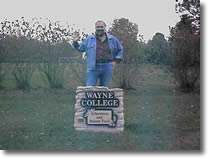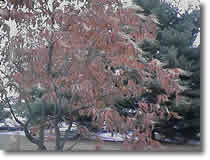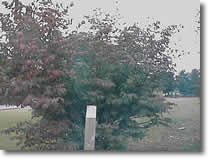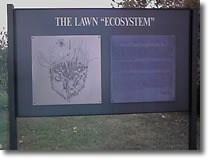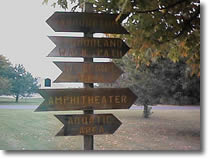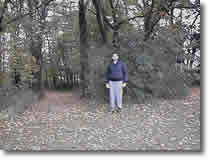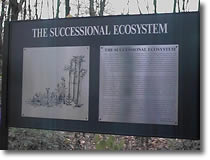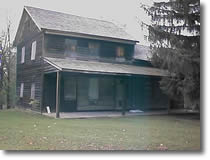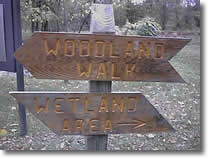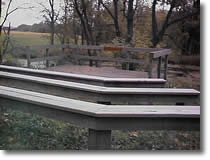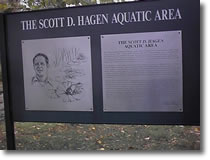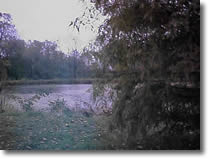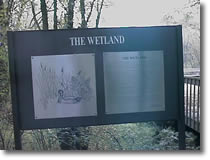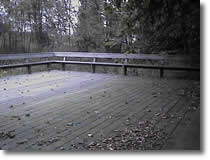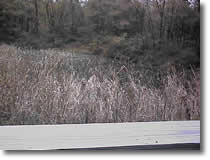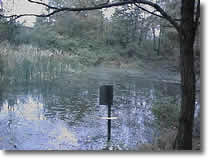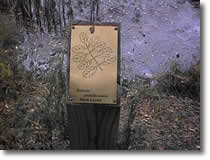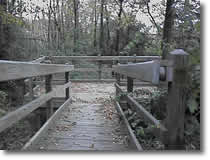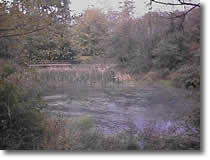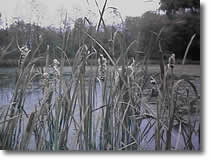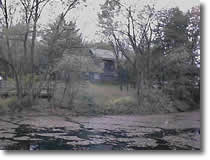The Images
(Click on picture for larger image)
|
Forrest J. Smith, Professor of Biology and designer of the Nature Trail and Arboretum welcomes you. The sourwood (Oxydendrum arboreum) has interest during at least three seasons. In the spring, its new foliage is a pretty bronze color, during the late summer, drifts of lily-of-the-valley appearing flowers decorate its branches. During the fall, as pictured in this image, the leaves often turn a beautiful red. Although this plant may grow twenty feet tall, it does so slowly and is well-suited for planting near foundations and buildings. This specimen has been in the Wayne College Arboretum since its inception in the 1970's. This plant with bright red leaves in the fall is burning bush (Euonymous alata compacta). It is a common landscape plant used in hedges or as specimen plants for its fiery red fall coloration. This specimen was donated by a neighbor of Wayne College in the late 1970's. The fact that it was dug during the summer and fell off the truck several times during transport is a testament to its hardiness. Besides its signature fall coloration, the burning bush also is known for four bark ridges along its branches which give it one of its alternative name, the cork-winged euonymous. Note the brass identification sign which includes common and scientific names and a student-made line drawing of important floral and/or vegetative features. Several different sorts of signs are found along the Nature Trail. This sign falls into the category of "educational signs" and includes an image and a text concerning a major topic of the environment. This sign covers the "Lawn Ecosystem" and chronicles the history of turf grass plantings in North America. Wayne College maintenance employees and student assistants fabricated these cedar signs from recycled bulletin boards which had been removed from the walls of the college. Wayne College Software Support Specialist and former student, Tom Hammond, stands at the entrance to the woodland walk. Snaking for several hundred feet, the Nature Trail at this point travels through a young woodland composed of black cherry (Prunus serotina), black locust (Robinia pseudo-acacia), and a number of young maples, ashes, redbud (Cercis canadensis), and even a few flowering dogwoods (Cornus florida). Because this is really a fairly young woods, it is likely that many changes will take place over the next decade or so as older cherries and locusts fall or die, and the ashes, maples and other later successional trees grow and dominate. This educational sign describes the "Successional Ecosystem", a process which can be observed along the Nature Trail. Any disturbed living system, if left alone, will grow through a fairly regular set of stages to create a stable mature ecosystem. Along the Nature Trail is the Barnett-Hoover Farmhouse, a log structure built originally in 1818. At this time, it is not in a usable state, but in the future might house meeting rooms, a small museum, and a land lab for outdoor education. It stands near the foundation of an old spring house. Both the farmhouse and the log house are on the National Register of historic places. Archaeological digs in the vicinity of the farmhouse in the past few years have yielded archaic age flint points, Civil War era coins, and numerous artifacts of many decades. (My personal favorite is a souvenir medallion showing the Golden Gate Bridge and no doubt commemorating a long ago visit to San Francisco. This is another directional sign at about the midpoint of the approximately half-mile-long trail. The "Student Senate Amphitheater" was donated by the Wayne College Student Senate in 1994/95. A portion of the lumber was donated by a local lumberyard, and the deck was built by artisans from The University of Akron Carpentry Shop. The tiered seating can accommodate seventy-five students. The small deck is good for both lectures and other sorts of events. The amphitheater was a dream of the late Scott D. Hagen, and lies near the south shore of one of the three ponds in the "Scott D. Hagen Aquatic Area". This educational sign memorializes the life and contributions of Scott D. Hagen, Associate Professor of Biology. Scott was present at the inception of the College and passed away suddenly in the prime of his career. |
This image was taken looking northeast over the second or middle farm pond in the Aquatic Area. Loaded with blue gills, bullfrogs, and a few lunker bass, this is the best "fishing pond" of the three. This particular view also lies across a twenty-year old bald cypress tree (Taxodium distichum). This tree is an unusual deciduous conifer native to the southern parts of the United States. More properly found in bayous and the everglades, this plant is nonetheless hardy in northern Ohio, the nearest native stand being found in southern Illinois. Wetlands are an integral part of the ecosystem of Northeast Ohio. A large section of the southeast part of the Wayne College campus is a wetland generated by springs flowing near the log farmhouse. This sign both describes the characteristics of a wetland and the three federal criteria which are used to delineate jurisdictional areas. This educational sign is near a deck which juts out into a "manufactured wetland" which resides in the basin of what was once the third of three farm ponds on the college property. In the early 1980's, the dam for this pond was broken to encourage shallower water. After a few years, a number of native wetland plants colonized and it is possible, by means of the deck, to "enter" the wetland and be surrounded by the wetland ecosystem. This view of the Wetland Observation Deck looks to the northeast. The treated wooden deck easily holds an entire class and includes a wide bench and banister upon which students can sit and take notes. Continuing the northeast view of Image #14, the basin of the wetland area is apparent. In the foreground is a large area of narrow leaf cattail (Typha angustifolia). Numerous wetland species live in and around this basin. The dam of the old pond is lined with small to medium-sized trees including species such as black locust (Robinia pseudoacacia) and black cherry (Prunus serotina). Looking back across the wetland area to the southeast, one can see the stand of cattails and the shallow water standing in the bottom of the old pond basin. In the foreground is a wood duck nest box. This box was made as a project for an ecology class. It mimics the holes in old trees which have become rarer as old forests are cut down. The shiny disk on the support pole helps to defeat raccoon and other predators from getting to the eggs and ducklings. Along the banks of the pond and along the Nature Trail and in the Arboretum are screen-printed brass signs such as this. The artwork was done by students. This sign depicts the black locust (Robinia pseudoacacia) a common tree species along the trail. East of the wetland area and along a slough which bisects the college property lies a small drainage stream. This small deck accesses that stream and its environs. This may also be a "jumping-off" place for future trail expansion. This is a more complete view of the wetland area, in this image, looking almost south. The deck, cattails, and surrounding trees are visible. Growing behind and near the deck is a common wetland indicator tree, the red maple (Acer rubrum). You can notice the leaves in this autumn image are starting to color up a bit. The red maple has some of the prettiest red leaves of any northeast Ohio trees. On the northeast corner of the second farm pond is a small clump of another species of cattail, the broadleaf (Typha latifolia). These plants came in here after dredging created a shallow shelf-like wetland near the edge of the pond. The lateness of the season is obvious by virtue of the ripe seed heads which are in the process of dispersing their seeds on fluffy parachutes. In this image, looking southward, one can see another aspect of the log farmhouse. The algae-filled, leaf covered first pond is also visible. Lines through the pond were probably made by animals such as muskrats or waterfowl. This pond is directly spring fed and there is both the remnants of a springhouse a the extreme right of the photo and several other springs which feed this small body of water. It stays open during all but the coldest of winters and is conversely very cool during the hottest of the summers. We have often placed soft drinks in the flow of the springhouse to keep them cold in the summer. |
![]()

